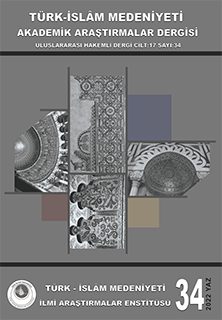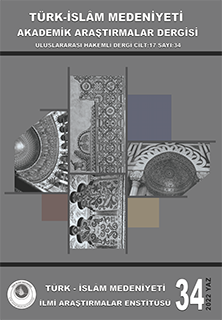Diyarbakır (Suriçi): Arsız Zaman(lar)ın Ayrıtında Kentsel ve Toplumsal Hafızada Renkleri Solan Kültürel Miras
DOI:
https://doi.org/10.5281/zenodo.6468482Anahtar Kelimeler:
Diyarbakır, Suriçi, Kültürel Miras, Toplumsal Dönüşüm/Çözülüş, Şiddete Dayalı OrtamlarÖzet
Mezopotamya, Anadolu ve İslam Uygarlıklarının süregelen değerleri üzerinden vücut bulan Diyarbakır (Suriçi) tarihi kentsel yerleşim dokusu (Camiler, kiliseler, hamamlar, anıtsal yapılar, kent surları ile geleneksel evler vb.), tarihsel olarak var olmuş farklı kültürlerin değerlerinden beslenerek; günümüze değin toplumsal ve kültürel yapıda varlık gösteren uzlaşıların bir yönünü temsil etmektedir. Zamanın düzleminde vücut bulan kültürel ve mekânsal aidiyet(ler); ortak birlikteliğin sürdürülen ve paylaşılan bir çevrenin temsiliyetine fırsatlar vermiştir. Tarihi kent(ler)in toplumsal ve mekânsal morfolojisi üzerinden yapı vurgusunu ön plana çıkaran “kültür ve mimari miras”; toplum katmanları ayrıtında yaratılan kültürel çoğulculuk ile doku deseniyle birlikte biçim alan yerleşimlerinin fiziki dokusuna ev sahipliği yapmaktadır. Bu değerler bütünselliğinde tanımlanan Diyarbakır tarihi ve mekânsal kentsel yerleşim örüntülerinin dünya mirası olma iddiası üzerinden dışa vuran fiziki farkındalığı, “Diyarbakır Kalesi ve Hevsel Bahçeleri Kültürel Peyzajı” tanımlamasıyla 2015 yılında UNESCO Dünya Kültürel Mirası Listesinde yer almasını sağlamıştır. Diyarbakır tarihi Suriçi bölgesi ile kentin çeperlerinde öbekleşerek süregelen göç ve 2015 yılının son aylarında ise ortaya çıkan şiddet/çatışmalı ortamdan kaynaklı durum; kentin hafıza temsiliyetini sağlayan kültürel ve mimari miras örüntülerinin ortaya çıkan şiddet sarmalıyla birlikte nasıl ve hangi sonuçlarla yüzleştiğinin tespiti üzerine yapılan bu çalışmayı önemli kılmaktadır. Çatışmalı ortam(lar) üzerine tartışılan ve de tarihsel bir hafıza dizgesi oluşturan kültürel mekân örüntülerinin ne kadar hayati bir öneme haiz olduğu; bu çalışmanın odağında tekrar gündeme getirilmektedir. Bu da olağan dönem veya durumlarda ortaya çıkması kuvvetle muhtemel “yeniden yapılanma” ve “inşa süreçlerine” bir katkı sağlayacağı umularak, şiddet sarmalında yok olan veya örselenen evrensel değerlerin sürdürülebilmesi için, uluslararası öneme sahip Diyarbakır Suriçi’nin yeniden gündeme getirilmesine katkı sağlayacaktır.
Referanslar
Atlı, M. (2014). Hepsi Diyarbakır, İletişim Yayınları, İstanbul.
Bachelard, G. (2017). Mekânın Poetikası, çev. Alp Tümertekin, İthaki Yayınları, İstanbul.
Bektaş, C. (2004). Kentli Olmak Ya Da Olmamak, Evrensel Basım Yayın, İstanbul, s.41.
Benjamin, W. (2017). Pasajlar, çev. Ahmet Cemal, Yapı Kredi Yayınları (YKY), İstanbul.
Berger, J. (2017). Kıymetini Bil Her Şeyin, çev. Beril Eyüboğlu, Metis Yayınları, İstanbul.
Bookchin, M. (2014). Kentsiz Kentleşme: Yurttaşlığın Yükselişi ve Çöküşü, çev. Burak Özyalçın, Sümer Yayıncılık, İstanbul.
Calvino, I. (2010). Görünmez Kentler, çev. Işıl Saatçioğlu, Yapı Kredi Yayınları (YKY), 2010, İstanbul.
Karasu, M. A. (2008). “Bir Kentin Ölümü: Kentkırım (Bosna-Hersek Örneği)”, Çağdaş Yerel Yönetimler, cilt:17, sayı:3, ss.51-64.
Kavafis, K. (2010). Kavafis’ten Yüz Şiir, çev. Cevat Çapan, Helikopter Yayınları, İstanbul, (“Şehir” adlı şiirinden).
Mai, U. (2016). “Doğu Alman Kentlerinde Kültür Şoku ve Kimlik Bunalımı”, Mekân Kültür İktidar, Ayşe Öncü ve Petra Weyland, (Der.), İletişim Yayınları, İstanbul.
Margosyan, M. (2013). Söyle Margos Nerelisen?, Aras Yayınları, , İstanbul.
Nietzsche, F. W. (1998). Böyle Buyurdu Zerdüşt, (Çev.) A. T. Oflazoğlu, Cem Yayınevi, İstanbul.
Öncü, A., Weyland, P. (2005). “Küreselleşen Kentlerde Yaşam Alanları ve Kimlik Mücadeleleri”, Mekân, Kültür, İktidar, (çev.) Leyla Şimşek ve Nilgün Uygun, İletişim Yayınları, İstanbul.
Salam, A. (1997). “Speech”, Reconstruction of War-Torn Cities, International Conference, Order of Engineers and Architects, 10-14 Kasım 1997, Beyrut, ss.7-9.
Sami, K. (2016). Diyarbakır Suriçi ve Çatışmalı Ortam: Gözü Mühürlü Mekânlar ve Yıkıma Direnen Kültürel Miras, Mimarlık, Sayı: 392, s.66-70.
Uyar, T. (2019). Aşkın Yıpranma Payı, Yapı Kredi Yayınları (YKY), 2019, İstanbul.
Tekeli, İ. (1991). Kent Planlaması Konuşmaları, TMMOB Mimarlar Odası Yayınları, Ankara.
Weber, M. (2012). Şehir: Modern Kentin Oluşumu, çev. Musa Ceylan, Yarın Yayınları, İstanbul.
İndir
Yayınlanmış
Nasıl Atıf Yapılır
Sayı
Bölüm
Lisans

Bu çalışma Creative Commons Attribution-NonCommercial 4.0 International License ile lisanslanmıştır.







